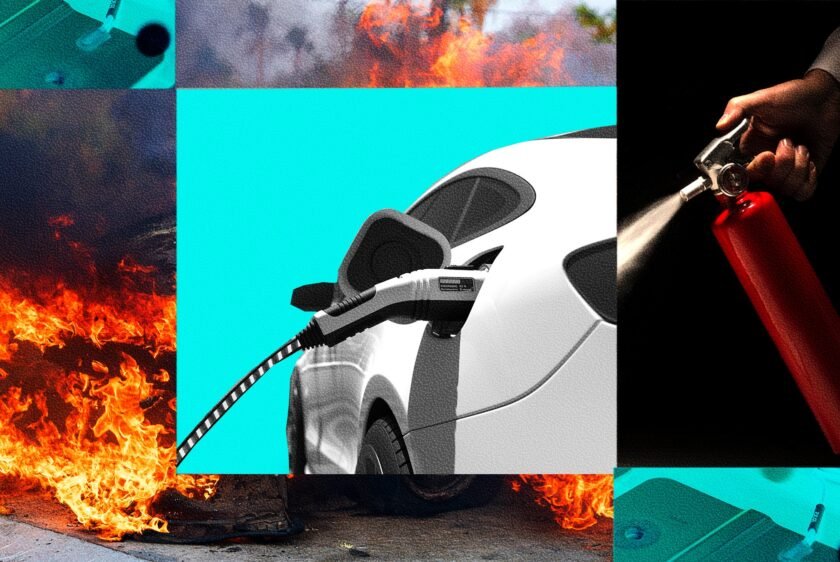Last month, a Mercedes Benz EQE 350 electric vehicle caught fire in a South Korean apartment building’s underground parking garage. Reportedly, 23 people were sent to the hospital and approximately 900 cars were damaged. The fire reached temperatures of more than 2,700 degrees Fahrenheit (1,500 degrees Celsius), and took firefighters almost eight hours to extinguish.
The incident led to a series of swift policy changes in the country, including the acceleration of a planned EV battery certification program and new rules in Seoul that should prevent owners from “overcharging” their vehicles in underground parking garages. It has also pushed automakers to do something they wouldn’t normally: reveal who makes the batteries inside their electric cars. (In early September, the South Korean government said it would require automakers to disclose this often secret information.)
Data from the National Transportation Safety Board, the US’s independent federal investigation agency, shows that the risks of electric vehicle battery fires are low. In fact, very low. An analysis of that data by one insurance company suggested that more than 1,500 gas cars catch on fire per 100,000 sales, compared to just 25 electric vehicles.
On some level, fire is a risk of any kind of battery technology. Professionals talk about the “fire triangle”—the three-ingredient recipe for ignition. Fire needs oxygen, a spark, and fuel. Because the point of a lithium-ion electric vehicle is to store energy, the fuel is always there. EV batteries are meant to be tightly packed and isolated from other parts of the car, but an incident like a catastrophic crash might quickly introduce oxygen and heat to the brew.
Building a Fire-Proof(ish) Battery
Some battery makers have taken steps to reduce the risk of their batteries catching fire. The first is to create stringent manufacturing processes and standards. This is important because any sort of flaw in a battery could lead to an inferno, says Venkat Srinivasan, who studies batteries and directs the Argonne Collaborative Center for Energy Storage Science at the US’s Argonne National Laboratory.
To understand why battery manufacturing matters to fire risk, you have to understand the basics of lithium-ion batteries. The battery’s anode and cathode store lithium, and they are connected by an electrolyte, a liquid chemical that passes lithium ions between the two to store or release energy. If, say, a tiny particle of metal gets into that electrolyte through an unclean manufacturing process, and it keeps getting electrified as the battery charges up and down, it could create a spark, open the battery cell, and allow oxygen to come rushing in and possibly expose the entire battery pack to fire.
These sorts of battery-making screw-ups do happen. In August, Jaguar told some 3,000 owners of its 2019 I-Pace SUV to park their vehicles outside because of fire risk, which was linked to three fires. The manufacturer behind those vehicles’ packs, the South Korean firm LG Energy Solution, has been subject to a US road safety probe since 2022. BMW, General Motors, Hyundai, Stellantis, and Volkswagen have all recalled vehicles over battery risks (some of them in hybrid rather than all-electric vehicles). But these situations are rare. Through solid manufacturing processes, “one can never make the risk of fire absolutely zero, but good companies have minimized the risk,” says Srinivasan.
Less Fire-y Chemistries
The good news is that less-fire-prone batteries are already rolling around in cars, thanks to specific battery chemistries that are harder to ignite. Since the first Tesla hit the road in 2008, the standard electric vehicle battery has been made primarily from nickel and cobalt. Batteries with this makeup charge quickly and hold lots of energy, which is great for EV use because drivers of vehicles that use them enjoy longer ranges and faster top-ups. They’re also more likely to enter “thermal runaway” at lower temperatures, in the 400- to 300-degrees Fahrenheit (210 to 150 degrees Celsius) range.
Thermal runaway is a state in which lithium-ion batteries enter a kind of fire doom loop: A damaged battery cell produces heat and flammable gases, which in turn produces more heat and flammable gases, which begins to heat nearby battery cells, which release more heat and gas. The fire then becomes self-sustaining and hard to put out.








